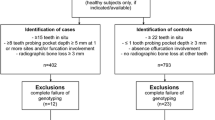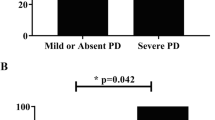Abstract
Recent studies have shown that genetic factors involved in the host responses might determine the disease severity for both familial Mediterranean fever (FMF) and periodontitis. The present study aimed to investigate the relationship of FMF with periodontitis and to search for the potential association between periodontitis and MEFV gene missense variations in patients with FMF. The study consisted of 97 FMF patients and 34 healthy volunteers. FMF patients were classified according to the kind of MEFV gene mutation: (1) patients with homozygous M694V gene mutation, (2) patients with heterozygous M694V gene mutation, and (3) patients with MEFV gene different mutations. Gingival Index (GI), Plaque Index (PI), probing pocket depth (PD), and clinical attachment level (CAL) were measured in all participants. The results of multivariate logistic regression showed a highly significant association between homozygous M694V gene mutation and periodontitis in FMF patients (p < 0.05). After adjusting for potential confounders (smoking, body weight, age, and gender), FMF patients with homozygous M694V gene mutation were 3.51 (1.08–11.45) times more likely to present periodontitis than the other FMF patients. These results indicate that the presence of homozygous M694V gene mutation seems to increase the risk for periodontitis in FMF patients.
Similar content being viewed by others
References
Ben-Chetrit E, Levy M (1998) Familial Mediterranean fever. Lancet 351:659–664
Gershoni-Baruch R, Brik R, Zacks N, Shinawi M, Lidar M, Livneh A (2003) The contribution of genotypes at the MEFV and SAA1 loci to amyloidosis and disease severity in patients with familial Mediterranean fever. Arthritis Rheum 48:1149–1155
Ozen S, Aktay N, Lainka E, Duzova A, Bakkaloglu A, Kallinich T (2009) Disease severity in children and adolescents with familial Mediterranean fever: a comparative study to explore environmental effects on a monogenic disease. Ann Rheum Dis 68:246–248
FMFC French (1997) A candidate gene for familial Mediterranean fever. Nat Genet 17:25–31
Anonymous (1997) Ancient missense mutations in a new member of the RoRet gene family are likely to cause familial Mediterranean fever. The International FMF Consortium. Cell 90:797–807
Milhavet F, Cuisset L, Hoffman HM et al (2008) The Infevers autoinflammatory mutation online registry: update with new genes and functions. Hum Mutat 29:803–808
Touitou I (2001) The spectrum of Familial Mediterranean Fever (FMF) mutations. Eur J Hum Genet 9:473–483
Inal A, Yilmaz M, Kendirli SG, Altintas DU, Karakoc GB (2009) The clinical and genetical features of 124 children with Familial Mediterranean fever: experience of a single tertiary center. Rheumatol Int 29:1279–1285
Pasa S, Altintas A, Devecioglu B et al (2008) Familial Mediterranean fever gene mutations in the Southeastern region of Turkey and their phenotypical features. Amyloid 15:49–53
Soylemezoglu O, Arga M, Fidan K et al (2010) Unresponsiveness to colchicine therapy in patients with familial Mediterranean fever homozygous for the M694V mutation. J Rheumatol 37:182–189
Akkoc N, Sari I, Akar S et al (2010) Increased prevalence of M694V in patients with ankylosing spondylitis: additional evidence for a link with familial Mediterranean fever. Arthritis Rheum 62:3059–3063
Grossi SG, Zambon JJ, Ho AW et al (1994) Assessment of risk for periodontal disease. I. Risk indicators for attachment loss. J Periodontol 65:260–267
Michalowicz BS, Aeppli DP, Kuba RK et al (1991) A twin study of genetic variation in proportional radiographic alveolar bone height. J Dent Res 70:1431–1435
Michalowicz BS, Aeppli D, Virag JG et al (1991) Periodontal findings in adult twins. J Periodontol 62:293–299
Nikolopoulos GK, Dimou NL, Hamodrakas SJ, Bagos PG (2008) Cytokine gene polymorphisms in periodontal disease: a meta-analysis of 53 studies including 4178 cases and 4590 controls. J Clin Periodontol 35:754–767
Karimbux NY, Saraiya VM, Elangovan S et al (2012) Interleukin-1 gene polymorphisms and chronic periodontitis in adult whites: a systematic review and meta-analysis. J Periodontol 83:1407–1419
Page RC (1998) The pathobiology of periodontal diseases may affect systemic diseases: inversion of a paradigm. Ann Periodontol 3:108–120
Touitou I, Sarkisian T, Medlej-Hashim M et al (2007) Country as the primary risk factor for renal amyloidosis in familial Mediterranean fever. Arthritis Rheum 56:1706–1712
Bostanci V, Toker H, Senel S, Sahin S (2014) Prevalence of periodontal disease in patients with Familial Mediterranean Fever: a cohort study from central Turkey. Quintessence Int 45:743–748
Bostanci V, Toker H, Senel S, Ozdemir H, Aydin H (2014) Effect of chronic periodontitis on serum and gingival crevicular fluid oxidant and antioxidant status in patients with familial Mediterranean fever before and after periodontal treatment. J Periodontol 85:706–712
Cengiz MI, Bagci H, Cengiz S, Yigit S, Cengiz K (2009) Periodontal disease in patients with familial Mediterranean fever: from inflammation to amyloidosis. J Periodontal Res 44:354–361
Cengiz MI, Yayla N, Cengiz K, Bagci H, Taskin E (2011) Interaction between periodontal disease and systemic secondary amyloidosis: from inflammation to amyloidosis. J Periodontol 82:566–574
Livneh A, Langevitz P, Zemer D et al (1997) Criteria for the diagnosis of familial Mediterranean fever. Arthritis Rheum 40:1879–1885
Ozen S, Demirkaya E, Amaryan G et al (2014) Results from a multicentre international registry of subject Mediterranean fever: impact of environment on the expression of a monogenic disease in children. Ann Rheum Dis 73:662–667
Delague V, Kriegshauser G, Oberkanins C, Megarbane A (2004) Reverse hybridization vs. DNA sequencing in the molecular diagnosis of Familial Mediterranean fever. Genet Test 8:65–68
Silness J, Loe H (1964) Periodontal disease in pregnancy. Ii. Correlation between oral hygiene and periodontal condition. Acta Odontol Scand 22:121–135
Loe H (1967) The Gingival Index, the Plaque Index and the Retention Index Systems. J Periodontol 38(Suppl):610–616
Armitage GC (1999) Development of a classification system for periodontal diseases and conditions. Ann Periodontol 4:1–6
Saag KG (2003) Glucocorticoid-induced osteoporosis. Endocrinol Metab Clin North Am 32(135–157):vii
Ben-Chetrit E, Bergmann S, Sood R (2006) Mechanism of the anti-inflammatory effect of colchicine in rheumatic diseases: a possible new outlook through microarray analysis. Rheumatology (Oxford) 45:274–282
Molad Y (2002) Update on colchicine and its mechanism of action. Curr Rheumatol Rep 4:252–256
Salai M, Segal E, Cohen I et al (2001) The inhibitory effects of colchicine on cell proliferation and mineralisation in culture. J Bone Joint Surg Br 83:912–915
Lidar M, Yonath H, Shechter N et al (2012) Incomplete response to colchicine in M694V homozygote FMF patients. Autoimmun Rev 12:72–76
Page RC, Offenbacher S, Schroeder HE, Seymour GJ, Kornman KS (2000) Advances in the pathogenesis of periodontitis: summary of developments, clinical implications and future directions. Periodontol 14:216–248
Nibali L, Ready DR, Parkar M et al (2007) Gene polymorphisms and the prevalence of key periodontal pathogens. J Dent Res 86:416–420
Chae JJ, Wood G, Masters SL et al (2006) The B30.2 domain of pyrin, the familial Mediterranean fever protein, interacts directly with caspase-1 to modulate IL-1beta production. Proc Natl Acad Sci U S A 103:9982–9987
Cantarini L, Volpi N, Galeazzi M et al (2010) Colchicine myopathy and neuromyopathy: two cases with different characteristics. J Clin Rheumatol 16:229–232
Kornman KS, Crane A, Wang HY et al (1997) The interleukin-1 genotype as a severity factor in adult periodontal disease. J Clin Periodontol 24:72–77
Guzeldemir E, Gunhan M, Ozcelik O, Tastan H (2008) Interleukin-1 and tumor necrosis factor-alpha gene polymorphisms in Turkish patients with localized aggressive periodontitis. J Oral Sci 50:151–159
Lachmann HJ, Sengul B, Yavuzsen TU et al (2006) Clinical and subclinical inflammation in patients with familial Mediterranean fever and in heterozygous carriers of MEFV mutations. Rheumatology (Oxford) 45:746–750
Compliance with ethical standards
ᅟ
Ethics approval
The study was approved by the Ethical Committee for the Use of Human Subjects in Research, Gaziantep University, Gaziantep (protocol number: 22.01.13/30).
Consent to participate
Written informed consent form was signed by all participants before the study.
Disclosures
None.
Author information
Authors and Affiliations
Corresponding author
Rights and permissions
About this article
Cite this article
Sezer, U., Şenyurt, S.Z., Özdemir, E.Ç. et al. Relationship between periodontal destruction and gene mutations in patients with familial Mediterranean fever. Clin Rheumatol 35, 1841–1847 (2016). https://doi.org/10.1007/s10067-015-3078-8
Received:
Revised:
Accepted:
Published:
Issue Date:
DOI: https://doi.org/10.1007/s10067-015-3078-8




